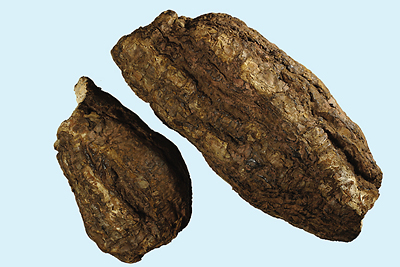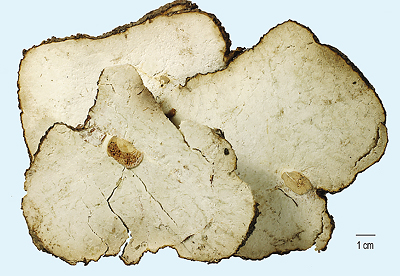Indian Bread
Indian Bread
Fuling
茯苓
Source
The sclerotium of Poria cocos (Schw.) Wolf (Fam. Polyporaceae).
Distribution
Mainly in Chinese provinces such as Yunnan, Hubei, Anhui and Guizhou. Cultivated or naturally grown.
Harvest & Processing
Dig out wild Indian Bread mostly in pine forests from July to the following March, or collect cultivated Indian Bread between July and August in the second year after inoculation. Heap up fresh Indian Bread to let moisture evaporate; repeat a few times until wrinkles show on the outer surface and most moisture on the inside has been driven out; dry in shaded areas to produce ' Fuling ge' (Intact Indian Bread).
Description
Fuling ge (Intact Indian Bread): lumps subspherical, ellipsoid (elliptical in long-section and circular in cross-section) or irregular in shape; varying in size. Exoperidium thin and rough; reddishbrown to dull blackish-brown; marked with prominent, protuberant wrinkles. Heavy; hard and solid. Broken surface uneven; outer layer pale brown; inner part white and granular, very occasionally pale red. Fuling kuai (Indian Bread in Pieces): pieces or slices cut from peeled Indian Bread; varying in size; sometimes with pine root remnants in the middle; white, pale red or pale brown.
Indications
1. Oedema, dysuria
2. Leukorrhagia
3. Cough
4. Diarrhoea, jaundice
5. Palpitaton, insomnia, dizziness, Chronic schizophrenia
Chemical Composition
Contains triterpenes such as pachymic acid and eburicoic acid; also contains polysaccharides such as pachyman.
Photos


